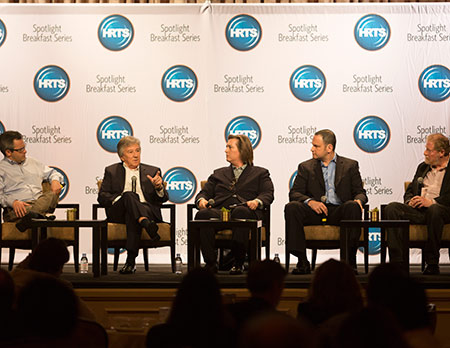Ratings Experts Split Over Future of Measurements

Beverly Hills, Calif. — While others see an upcoming inflection point for the business of audience measurement, Preston Beckman, a media consultant and former executive with Fox Broadcasting, instead compared what’s happening to Los Angeles’ notorious Interstate 405.
“It’s constantly under construction,” he quipped during an April 12 discussion about the future of TV ratings and measurements, held by the Hollywood Radio and Television Society. “I don’t see it as a turning point.”
At least Gian Fulgoni, cofounder and chairman of comScore, and Eric Solomon, senior VP of product leadership for Nielsen, agree on something.
Related: Nielsen Seeds Cloud With Marketing Data
The two do see a major turning point for the way ratings and measurements are going to be handled. They just see it being done differently. Nielsen’s long-promised Total Audience Measurement cross-platform measurement tool will continue to use panels as its foundation when it becomes widely available this year, while comScore, via its recently announced partnership with Adobe Analytics, will use census data for its new model for cross-platform measurement.
“It’s gotten fragmented beyond anything we ever expected and it puts pressure on the measurements we use,” he said. “The legacy, limited-person panel model just doesn’t cut it. To solve the measurement problem … you just have to come up with a new model, a new measurement approach.
Related: #AdvancedAd 2016: Total Audience a ‘Framework'
The smarter way to stay on top of broadcasting and cable industry. Sign up below
“The tech changes we’re seeing today are of the likes we’ve never seen before, and it’s accelerating. It’s a turning point in the design of measurement that’s needed, and you need to do it at scale.”
But Solomon defended Total Audience Measurement, saying Nielsen’s “making sure all TV and all the pieces of TV, and digital and all the pieces of digital, are counted in a way that’s valuable to our clients.”
Related: Analyst—Dish Data Deal Helps Nielsen
Julie Piepenkotter is just happy it’s happening. The executive VP of research for FX Networks said true cross-platform measurement in the digital age has been a long time coming, and programmers will benefit. But it won’t be easy, she added.
She pointed to a Facebook Live stream April 8 of two Buzzfeed employees spending 45 or so minutes putting rubber bands around a watermelon. The stream drew nearly 3 million viewers, and at one point had more than 800,000 concurrent viewers. But Piepenkotter was quick to note that that peak viewership number was for just a couple seconds of the video. If the same metrics were applied to her network’s The People v. O.J. Simpson: American Crime Story, FX could say they had 144 million hours viewed. “Cross platform comparisons are difficult,” she said. “Digital is the new shiny thing, but there’s nothing like the engagement and richness that television provides.”
Related: Nielsen Gets Set-Top Viewer Data From Dish
The panelists eventually turned their conversation toward Netflix, with Beckman predicting that the streaming media giant would eventually cave in and start tapping the advertising revenue stream. That would open up something the industry at large has long wanted to know: how do each of these shows on Netflix actually perform?
“If you’re licensing content to Netflix, you would want to know how that content is performing,” Fulgoni said.
Until Netflix does start showing ads, Piepenkotter isn’t going to worry about how that company’s content is performing. “I’m not losing sleep about Netflix, they’re not part of the buying and selling world we live in,” she said.
